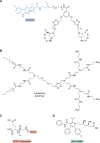Cell adhesion in cancer: Beyond the migration of single cells
- PMID: 31937589
- PMCID: PMC7039572
- DOI: 10.1074/jbc.REV119.007759
Cell adhesion in cancer: Beyond the migration of single cells
Abstract
Homeostasis in healthy tissues strongly relies on cell-to-cell adhesion and cell-to-extracellular matrix interactions. For instance, normal epithelial cells maintain tissue structure by adhering to each other and to the extracellular matrix. The proteins that mediate these distinct interactions are collectively called cell adhesion molecules and are divided into four major groups: cadherins, integrins, selectins, and immunoglobulins. They not only physically anchor cells, but also critically integrate signaling between the extracellular microenvironment and cells. These signals include biochemical cues, as adhesion proteins can both act as ligand-activated receptors and activate mechanotransduction triggered by changes in the physical environment. Molecular mechanisms related to cell adhesion signaling have been extensively studied, especially because mutations and changes in expression of these proteins, particularly cadherins and integrins, are frequently associated with diseases ranging from developmental intellectual disability to cancer. In fact, two major hallmarks of cancer, loss of cell-to-cell adhesion and anchorage-independent growth, are both dependent on cell adhesion molecules. Despite many studies elucidating the relationships between malignant transformation and metastasis and cellular adhesion processes, several areas still await exploration. Here, we highlight recently discovered roles of adhesion molecules in collective cancer cell migration and discuss the utility of three-dimensional models in studying cell-cell adhesion. We also describe recent therapeutic approaches targeting adhesion molecules.
Keywords: cadherin; cancer; cancer biology; cancer stem cells; cell adhesion; cell adhesion molecules; collective migration; epithelial-mesenchymal transition; integrin; organoids; targeted treatment.
© 2020 Janiszewska et al.
Conflict of interest statement
The authors declare that they have no conflicts of interest with the contents of this article
Figures



References
-
- Ko K. S., Arora P. D., Bhide V., Chen A., and McCulloch C. A. (2001) Cell-cell adhesion in human fibroblasts requires calcium signaling. J. Cell Sci. 114, 1155–1167 - PubMed
Publication types
MeSH terms
Grants and funding
LinkOut - more resources
Full Text Sources
Medical

